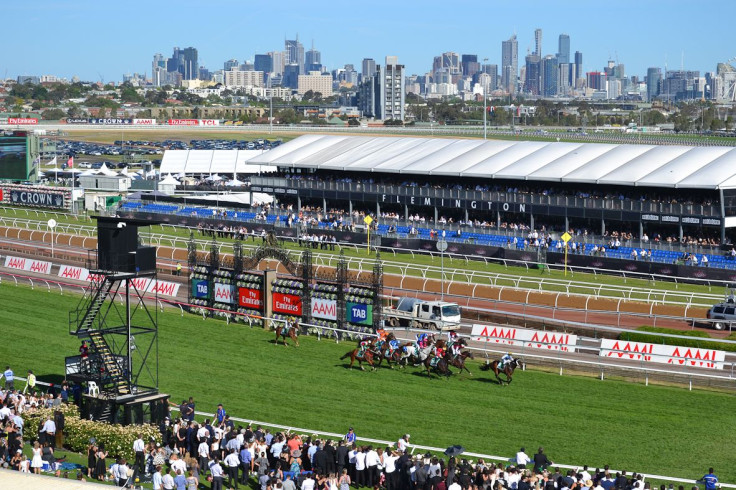Melbourne Cup Carnival: Where Horse Racing Plays Second Fiddle To Pomp And Circumstance

Melbourne is a city best known internationally as an edgier alternative to show-stopping Sydney. It’s the capital of cool -- a bogan-free enclave of graffiti-lined laneways, creamy coffee and artistically attuned citizens.
It’s Australia’s answer to Brooklyn.
But there’s another side to Melbourne that’s equally radiant and much-less scribbled about on the far side of the equator: its sport scene. Melbourne is as sport-obsessed a city as any, and at no time is that more apparent than when the Melbourne Cup Carnival comes a galloping into town.
The United States has its Kentucky Derby and England its Royal Ascot, but what happens at Melbourne’s Flemington Racecourse each November is of another caliber altogether. Of the three prestigious horseracing events, the Melbourne Cup Carnival not only attracts the largest crowds (roughly 350,000 people over four days) but also has the most jaw-dropping of purses (A$17.3 million, or about US$16.4 million, in prize money, nearly double that of the other two combined).
Moreover, the Emirates Melbourne Cup literally brings a nation to a standstill, with workers flooding out of their offices for the pub on the first Tuesday afternoon of November for what is, indisputably, the most-watched 200 seconds on Australian television each year.
The broader Melbourne Cup Carnival consists of four key racing dates: AAMI Victoria Derby Day (Nov. 2), the 153rd Emirates Melbourne Cup (Nov. 5), Crown Oaks (Nov. 7) and Emirates Stakes Day (Nov. 9). Of the four, the Melbourne Cup is the must-see “race that stops the nation,” but it’s Derby Day that’s actually the oldest (first contested in 1855, six years before the Melbourne Cup) and often the most attended. It launches the Spring Carnival into full gear and sets the tone for the days to come.
If you were lucky enough to score a ticket to Flemington Racecourse’s coveted Rose Room this past Saturday, as I was, this is what you would have found: rows upon rows of black and white dresses and morning suits sitting together at tables topped with nugget-size morsels of delectable “palate refreshers” and sipping cocktails through paper straws. You’d find a makeup artist in the women’s room, a shoe-shining booth by the men’s room, roaming bookies in one corner, champagne reps in town from Paris in the other, and a seemingly endless window overlooking the racecourse and the Melbourne skyline beyond, which may as well have been an afterthought to the action inside.
In the Rose Room -- and every other class of viewing at Flemington Racecourse -- the heart-stopping equine spectacle plays second fiddle to the pomp and circumstance of seeing and being seen. Case in point: Just as jockeys took to the turf for the AAMI Victoria Derby, the day’s main race, British supermodel Naomi Campbell stepped out in front of the Lexus marquee. Though she was 90 minutes behind schedule, naturally, all cameras were on her.
Campbell wasn’t the only one strutting around the Birdcage, a limited-access area separated from the racecourse by a wall of flowers that blocks any direct view of the jockeys. American fashion model and reality-TV host Tyson Beckford, British singer Mel B (aka “Scary Spice”) and a coterie of Aussie celebs including former Miss Universe Jennifer Hawkins and musician Timomatic similarly kept eyeballs off the racecourse. They also helped accomplish two other things: maintaining the Victoria Racing Club’s prestigious aura and keeping the state coffers rolling in dough.
Last year, the star-studded four-day Melbourne Cup Carnival’s added contribution to Victoria’s gross state product was estimated at A$176.58 million by researchers at consulting firm IER Pty Ltd. Victorian businesses also benefited from a A$336.15 million financial stimulus (gross economic benefit), while nationally, the economic output generated by spending associated with the Carnival reached more than A$751.59 million.
Fashion spending alone topped A$29.6 million, meaning the average racegoer forked over more than A$160 for their outfit. Much of that money went into purchasing 65,000 hats and fascinators, an elaborate piece of headgear that defies gravity and has become a staple of racewear from Louisville, Ky., to Melbourne.
The cost of my own race outfit put me on par with the average, though, as a male, I didn't have to navigate the feathery wilds of the fascinator aisle. The task, however, sent me racing across Melbourne a few days prior to Derby Day, thinning out my wallet from the hipster Fitzroy neighborhood to yuppie Prahran.
I hunkered down for the actual race weekend at the impeccably renovated Pullman Melbourne Albert Park Hotel, whose new interior design drew to mind the sets of “Mad Men” and “2001: A Space Odyssey” in equal measure. It was from there that I set out for Flemington on Saturday morning, and it was just outside that I met a seasoned racegoer who offered two tidbits of advice.
No. 1: “Pace yourself with the bubbly.”
“You don’t want to end up on the nightly news,” she said, explaining a tradition of giving celebrities and drunken revelers equal coverage. “Trust me, you’ve never seen so many beautifully dressed drunkards as you will at 5 o’clock this afternoon.”
No. 2: “Don’t bet too much.”
“Or do,” she added. “Who knows, you might come back and buy this hotel.”
Buy the Pullman I didn't, but I did come away with $50 and a dangerous desire to bet again. I also returned to Melbourne’s city-center with some of the most gorgeous midday boozers I’ve ever seen, some of whom had an acute talent for turning perky thousand-dollar fascinators into flaccid sleep shields.
Departing the train at Flinders Street Station, the girls flopped away down Melbourne’s graffiti-glittered streets like fallen swans, aided ever-so-slightly by the wobbling penguins they called their lovers.
Thousands of champagne bottles, dresses, hats, shoes, ties, taxis, hotel rooms and erroneous bets later, day one was complete. But the Melbourne Cup Carnival was only just beginning.
© Copyright IBTimes 2024. All rights reserved.






















